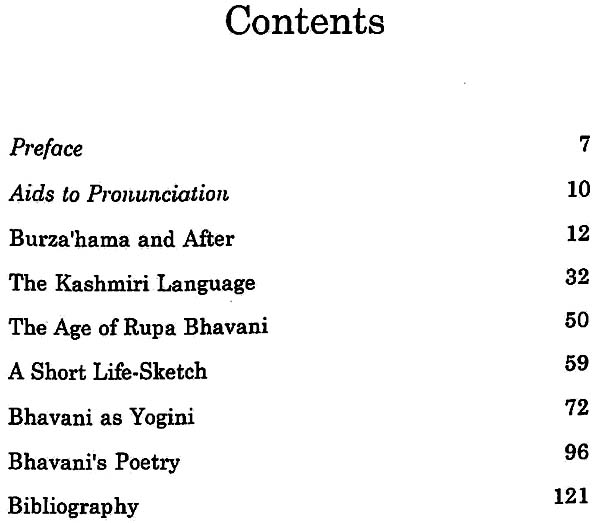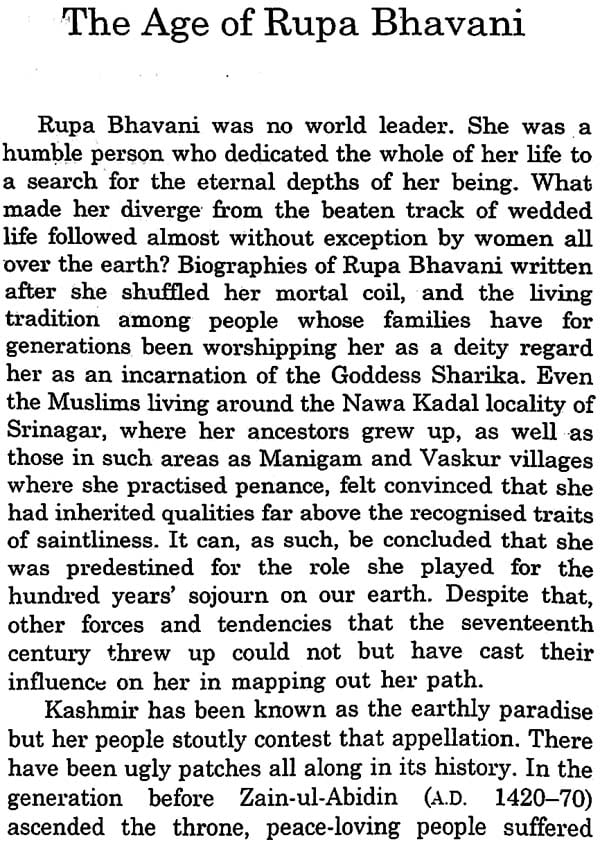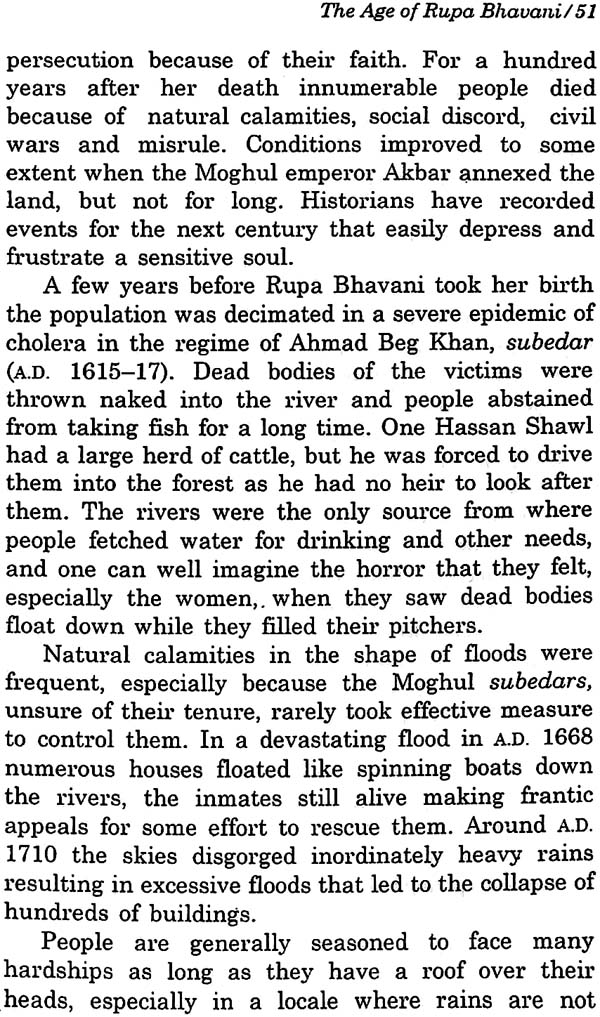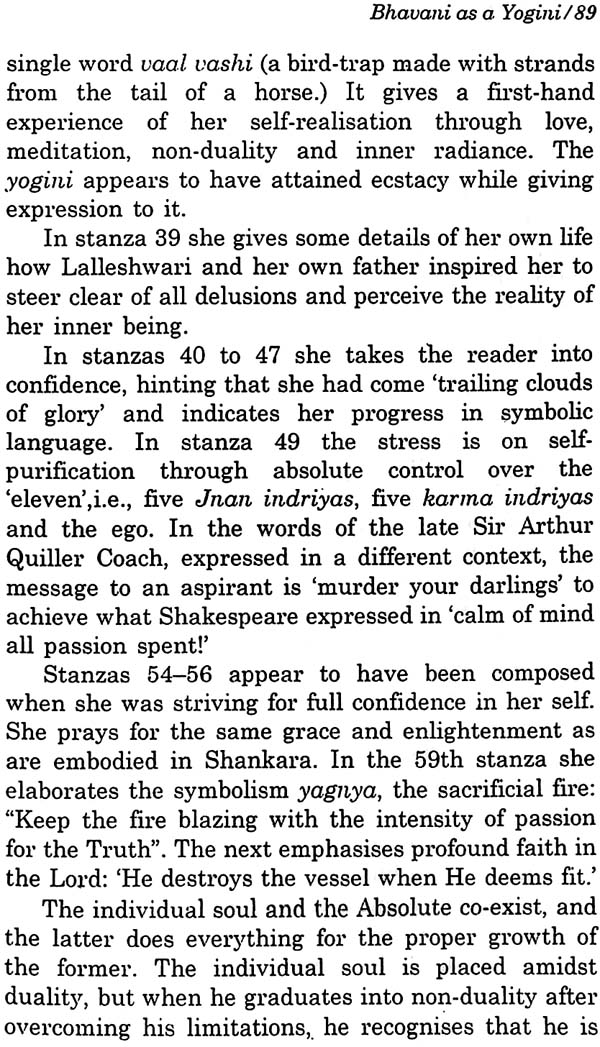
Rupa Bhavani
Book Specification
| Item Code: | NAQ564 |
| Author: | S.L. Sashu |
| Publisher: | SAHITYA AKADEMI, DELHI |
| Language: | English |
| Edition: | 2003 |
| ISBN: | 8126009225 |
| Pages: | 121 |
| Cover: | PAPERBACK |
| Other Details | 8.50 X 5.50 inch |
| Weight | 100 gm |
Book Description
Rupa Bhavani (1625-1721) is the second well-known mystic poet of Kashmir after Lal Ded. Born in 1625 (some say 1621), with her mastery in Sanskrit, Persian and Hindustani, she was well-versed in Vedanta, Upanishads and Shaivism. Her vaakhs have come to us in the usual oral tradition. It is believed that the Hindi text entitled Rupa Bhavani Rahasyopadesha (the mysterious spiritual. teachings of Rupa) is the most detailed text available. It is generally said that the language of her vaakhs is archaic, with more than one meaning to what she said. Her vaakhs show the influence of Kashmir Shaivism and Islamic Sufism.
Her poetry appears to be rooted in her predestined role as a Yogini. It is in this role that she has touched the lives of common people since the days when she acquired fame for her 'miracles'. Though Rupa Bhavani spent virtually the whole of her life in meditation and there is little evidence-that she ever attempted the art of composing poetry, the vaakhs which have come down to us as hers show definite signs of rare poetic genius and meditative maturity:
S.L. Sadhu (b. 1917) writes in Kashmiri and English. He has eleven books to his credit, which include Folk Tales from Kashmir and Habba Khatoon. He is a recipient of many awards including J&K Cultural Academy Award.
The oldest chronicle of Kashmir now extant, the Rajatarangini, starts narrating events from around the Mahabharata war in which the then ruler of the area lost his life. A settled kingdom, Kashmir looked back another two millennia to the age when people lived at Burzahama, near the Dal Lake, to the east of Srinagar. Some sort of continuation in the life of the area appears to be traceable, directly or indirectly, since then. It would be logical to survey the growth of Kashmiri sensibility, life, thought and culture since the days of Burzahama settlement, though large areas of darkness are found in the extensive scenario. Comprehensive research is called for to establish salient milestones before reliable conclusions emerge.
Rupa Bhavani lived for about a hundred years in the 17th-18th centuries. It was a period when the Kashmiri language was still not out of the woods. During the two centuries, however, it acquired a clear-cut personality and character. Rupa Bhavani also played an important role in that process. A study of the growth of Kashmiri language over the centuries is helpful in assessing her contribution to the language.
A writer is indebted to his age for how it nourishes him/ her, the age being the treasure-house of what it has inherited from the past and the shape it can give it in its own turn. A brief account of the important events and of the various social and cultural trends of the hundred years that Rupa Bhavani sojourned on the earth appears to be indispensable even though she lived the insulated life of a recluse for eight decades.
Rupa Bhavani's vaakh are meant, by and large, for an audience of aspirants, those who want to reach the everlasting Truth and engage themselves in the struggle for self-realisation. Her poetry appears to be rooted in her predestined role as a Yogini and, as such, claims maximum attention. It is in this role that she has touched the lives of common people from the days when, through her occult powers, she acquired fame for 'miracles', and for over two centuries after she breathed her last. It is to be borne in mind that she is remembered and worshipped by lakhs of people as an incarnation even now. The anniversary of the day of her merger with the Absolute, as well as the half-yearly rituals, are being celebrated regularly as a solemn festival, with fasting, ceremonials and havans.
Rupa Bhavani's vaakhs have been recorded by her admirers in several manuscripts. Apart from a few printed versions of the recent past, nine manuscripts incorporating them have surfaced so far, the oldest among which is believed to belong to a devotee in village Pingalena. Inevitably, there are variations in the texts of different editions and manuscripts. It is highly desirable that various bodies interested in her vaakhs, including the P.G. Department of Kashmiri at the Kashmir University, the Alakeshwari Trust (now in Jammu), the J&K Academy of Art, Culture and Languages and the Sahitya Akademi, New Delhi, joined hands in preparing a definitive edition. Such a work would be in the interest of Kashmiri language and poetry also.
The undersigned is grateful to the authors of a number of books that have helped him in preparing the present. monograph. The sources have been acknowledged in the footnotes, wherever possible, and in the Bibliography. He offers apologies to authors whose names may have been missed through an oversight.












